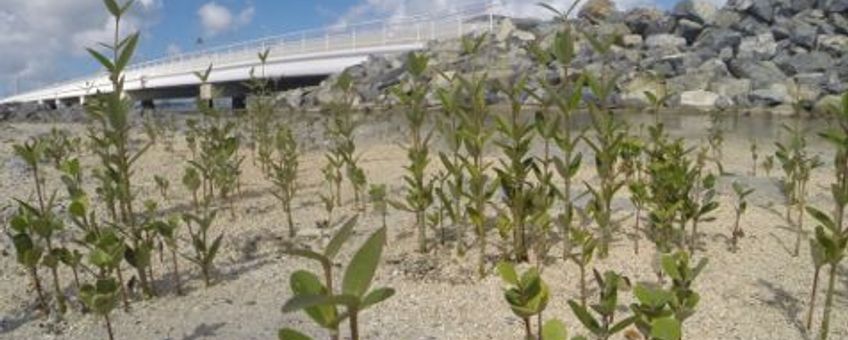
Herplanting van mangroven in de Simpson Bay op St. Maarten
Bericht uitgegeven door Dutch Caribbean Nature Alliance (DCNA) [land] op [publicatiedatum]
In mei 2012 is men op St. Maarten begonnen met de aanleg van het Simpson Bay viaduct om de internationale Prinses Juliana luchthaven met de oostoever van de baai te verbinden. Grote delen van het aanwezige mangrovenbos moesten plaatsmaken voor de aanleg van het viaduct. Ter compensatie voor dit verlies zijn in het begin van het project bijna 8.000 jonge mangroven zorgvuldig verwijderd en elders in de baai en rond het eiland opnieuw geplant. Deze herplanting, waarbij meerdere herbebossingstechnieken zijn gebruikt, is uitgevoerd in combinatie met een monitoringsprogramma om uiteindelijk het succes van het project te kunnen meten. In januari van dit jaar is een gebied ter grootte van 600 vierkante meter onderzocht en de conclusie is dat het project aanslaat. Sterker nog, het is een van de succesvolste herbebossingsprojecten op St. Maarten ooit.
Lees verder in het Engels…
In May 2012, the construction of the Simpson Bay Lagoon Causeway on St. Maarten began, connecting the Princess Juliana International Airport to the eastern shore of the lagoon. Large sections of the mangrove forest present in the bay had to give way to the causeway construction. To compensate for this loss, in the initial stage of the project almost 8,000 juvenile mangroves were removed and have been replanted in the Simpson Bay Lagoon itself and at various other locations around the island.

Along with the replanting, which utilized a variety of ecosystem-based reforestation techniques, a monitoring programme was put in place to measure success. In January 2014 an area of 600 square metres was surveyed and it demonstrated that this reforestation project was working, and even one of the most successful mangrove reforestation initiatives on the island to date.
Mangrove forests are under severe pressure and disappearing at an alarming rate. It is estimated that approximately 60% of the total mangrove areas on St. Maarten have been lost. In the Simpson Bay Lagoon, all four species of mangroves are still present: Red Mangrove (Rhizophora mangle), Black mangrove (Avicennia germinans), White Mangrove (Laguncularia racemosa) and Buttonwood (Conocarpus erectus).
During the Nature Foundation’s monitoring, a number of invertebrate species that rely on mangroves in some way or another were recorded, including Queen Conch (Lobatus gigas), Red Cushion Sea Stars (Oreaster reticulata), Donkey Dung Sea Cucumber (Holothuria mexicana), and the Upside Down Jellyfish (Cassiopeia frondosa). The fact that these species are present is an encouraging sign for the overall health of the ecosystem.

Mangroves provide a filter for runoff water from the land that prevents harmful sediments from smothering coral reefs, including those of the Man of War Shoal Marine Park, just south of St. Maarten. When established successfully, the mangrove trees have the potential to become a thriving habitat for many other plants and animals as well as an important nursery for many species of fish, such as Schoolmaster (Lutjanus apodus), Gray Snapper (Lutjanus griseus), Great Barracuda (Sphyraena barracuda) and the Foureye Butterfly Fish (Chaetodon capistratus).
As a next step in this project, additional mangroves will also be planted on the western edge of the causeway landing and constant management and regular monitoring will be carried out to ensure the survivability of the mangroves planted.
Read the entire article in BioNews
Text: Dutch Caribbean Nature Alliance (DCNA)
Photo's: Tadzio Bervoets, St. Maarten Nature Foundation
Published by: Dutch Caribbean Nature Alliance (DCNA)
Nederlandse inleiding: Paul Westerbeek, Dutch Caribbean Nature Alliance
